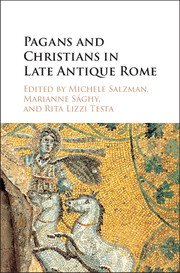 Pagans and Christians in Late Antique Rome
Pagans and Christians in Late Antique Rome Book contents
- Frontmatter
- Contents
- List of Illustrations
- Biographies of Authors
- Acknowledgments
- Introduction
- Part I SENATORIAL POLITICS AND RELIGIOUS CONFLICT
- Part II The Construction of New Religious Identities
- 4 Christians and the Invention of Paganism in the Late Roman Empire
- 5 Late Antique Divi and Imperial Priests of the Late Fourth and Early Fifth Centuries
- 6 Artis heu magicis : The Label of Magic in Fourth-Century Conflicts and Disputes
- 7 Crowd Behavior in Late Antique Rome
- Part III Pagans and Christians: Coexistence and Competition
- Section A Pagans and Religious Practices in Christian Rome
- Section B Death and the Afterlife
- Section C Reading Religious Iconography as Evidence for Pagan–Christian Relations
- Concluding Remarks: Vrbs Roma between Pagans and Christians
- Index
- References
5 - Late Antique Divi and Imperial Priests of the Late Fourth and Early Fifth Centuries
from Part II - The Construction of New Religious Identities
Published online by Cambridge University Press: 05 November 2015
- Frontmatter
- Contents
- List of Illustrations
- Biographies of Authors
- Acknowledgments
- Introduction
- Part I SENATORIAL POLITICS AND RELIGIOUS CONFLICT
- Part II The Construction of New Religious Identities
- 4 Christians and the Invention of Paganism in the Late Roman Empire
- 5 Late Antique Divi and Imperial Priests of the Late Fourth and Early Fifth Centuries
- 6 Artis heu magicis : The Label of Magic in Fourth-Century Conflicts and Disputes
- 7 Crowd Behavior in Late Antique Rome
- Part III Pagans and Christians: Coexistence and Competition
- Section A Pagans and Religious Practices in Christian Rome
- Section B Death and the Afterlife
- Section C Reading Religious Iconography as Evidence for Pagan–Christian Relations
- Concluding Remarks: Vrbs Roma between Pagans and Christians
- Index
- References
Summary
Now that new contributions have been made to the study of “the imperial cult” in the early Roman Empire, the time is ripe to broaden that conversation: by drawing attention to imperial cult practices in the late Roman world. This topic will provide an excellent illustration of how our modern categories, like “Roman/Christian” or “pagan/Christian,” fail to capture the nuances of social life in the late Roman world. Two recent studies – one focusing on divus Constantine, the other on the iconography of Christ as the heavenly emperor – have already begun to sketch out that picture.
This contribution expands on that work by examining the social and cultural context of one inscription from Rome (CIL 6.1783). This inscription has recently been used to characterize the late fourth and early fifth centuries as a period of “Christian triumph” and “pagan revival” although that narrative no longer withstands scrutiny. Traditional worship practices did not vanish with the conversion of Constantine; and abundant epigraphic, legal, numismatic, and textual sources, discussed here, attest to the continued practice of naming late antique emperors divi – including references to the diva memoria of the eastern Roman emperor Zeno (474–91 CE) and one reference to divus Anastasius (491–518 CE). Given this context, it is surprising, however, that no scholar to date has chosen to discuss the fact that the inscription from Rome names the emperor Theodosius as divus.
This chapter rereads that inscription in light of the resilience of traditional Roman worship practices in the fourth century, including imperial cult practices. In doing so, it suggests a model for understanding how the same social and cultural mechanisms by which individuals and communities drew the attention and patronage of the imperial house, as in earlier periods, remained an important “transactional” mechanism for brokering social relations in the late antique world. This chapter may challenge scholars who see “the imperial cult” as a phenomenon inherently in tension with early Christianity or as one whose outward “pagan” trappings were thrown off with the legalization of Christianity.
Rome, circa 431 CE
Few inscriptions have merited their own monograph. CIL 6.1783 is privileged to count among this group. Discovered in Rome in 1849 in the Forum of Trajan, the inscription dates to 431 CE and preserves a letter from Flavius Theodosius II and Flavius Valentinian III to the Senate of Rome.
- Type
- Chapter
- Information
- Pagans and Christians in Late Antique RomeConflict, Competition, and Coexistence in the Fourth Century, pp. 139 - 161Publisher: Cambridge University PressPrint publication year: 2015
References
- 1
- Cited by


